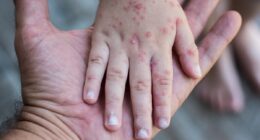
Amy Robach, co-anchor of Good Morning America’s third hour GMA3, shared that she has a COVID breakthrough infection—and almost missed her symptoms.
On Thursday, Robach gave an update on her health saying that after getting a COVID diagnosis, she’s “quickly on the mend,” crediting being vaccinated and boosted for her mild symptoms. Her symptoms were so mild, in fact, she didn’t immediately realize they could be related to a COVID infection. “I had exhaustion and lower back pain last weekend – not putting two and two together that those were early omicron symptoms… Just thought I was pushing myself too hard with my training runs!!” she wrote on Instagram.
Instagram content
This content can also be viewed on the site it originates from.
READ RELATED: Andy Whyment health: Coronation Street star's deadly condition – symptoms revealed
As the coronavirus has evolved from the alpha variant, to the delta variant, to the omicron variant, so too have common COVID symptoms. With omicron in particular, people are more likely to experience mild symptoms similar to the common cold, as SELF previously reported. From an illness perspective, that’s great. But milder symptoms can make detection—and the risk that you could be unknowingly spreading omicron—more challenging. The most common symptoms of omicron, as NBC reported, are cough, congestion, headache, sore throat, and, as Robach reported in her own case, fatigue.
It turns out, noticeable fatigue is an extremely common sign you may have omicron: An early analysis of omicron cases conducted by the Centers for Disease Control and Prevention (CDC) found that 65% of people reported fatigue as a symptom. Body aches are also a common and easy-to-miss COVID symptom (though not one that’s been as closely associated with omicron cases based on what we know so far), according to the CDC.
Robach’s story highlights just how easy it is to miss an omicron infection. Nearly two years into the pandemic, who isn’t feeling fatigued? And who isn’t used to pushing through it? Robach was “even able to jog a few slow miles in the snow,” after getting diagnosed, she wrote (adding that she wasn’t running where other people were present).
Source: SELF








